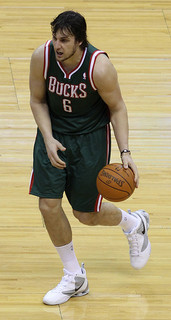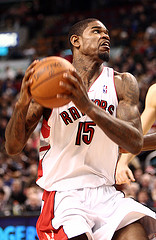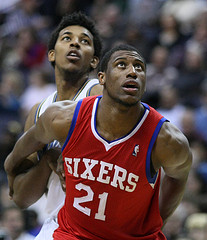Fantasy Basketball Primer Part 3 – Custom League Settings
In Parts 1 and 2 of this series, I introduced you to the Fantasy Basketball Primer and reviewed Head-to-Head, Rotisserie and Keeper League strategies. Today we look at some common league rules and settings, how they will inform your strategy and who are the right players for your league.
Know Your League Rules and Settings
Fantasy basketball rules can vary widely across leagues, as hosting websites offer more and more customization. Apply a little imagination and the combinations are virtually endless. Yesterday, we discussed some settings for a fun and unique league. All of these variations create opportunities for fantasy players, because the bulk of the fantasy opinion, player rankings, cheat sheets, etc., are based on a particular set-up. The differences between your league and the most common set-ups are opportunities for you to gain an advantage.
The easiest way to learn of these opportunities is to compare your league’s settings to the default public league settings of your hosting site. Each difference presents an opportunity for you to exploit. Your competition will be largely influenced by the content on the hosting site’s player rankings, add and drop lists, etc., so your ability to identify players who are worth more in your league than in default leagues gives you an immediate leg-up.
I break down the various settings and rules in three groups: Settings that affect the Available Player Pool, Transaction Limits and Scoring.
Settings That Affect the Available Player Pool
How many teams are in your league? Common settings are 10, 12 and for the adventurous, 20. How many roster spots per team? How many bench spots? What are the position eligibility requirements? Is position eligibility easily obtained or very rigid? Each of these settings directly affects the available player pool once the draft is complete.
Shallow Leagues
 Leagues with large available player pools — commonly known as ‘shallow leagues’ — have few teams, few roster spots and loose player eligibility requirements. Shallow leagues favor a high-risk strategy, where you try acquire as much upside as possible with almost plain disregard to downside, because the average performance of a roster spot is very high and the cost of a mistake very low. The large available player pool means that you will have a lot of options for replacements, in the event that your risk does not pan out.
Leagues with large available player pools — commonly known as ‘shallow leagues’ — have few teams, few roster spots and loose player eligibility requirements. Shallow leagues favor a high-risk strategy, where you try acquire as much upside as possible with almost plain disregard to downside, because the average performance of a roster spot is very high and the cost of a mistake very low. The large available player pool means that you will have a lot of options for replacements, in the event that your risk does not pan out.
One potential target in shallow leagues, especially with long benches or injury spots, are ‘productive when healthy’ types like Andrew Bogut or Stephen Curry. You should be able to acquire these players at a significant discount because of the injury risk or negative stigma, but you will get above-average performance if/when they are healthy. If/when they succumb to injury, you can simply play someone else.
Deep Leagues
Deep leagues with many teams, long rosters and rigid player eligibility favor a low-risk strategy. The gap between the player you drafted and the players on the waiver wire can be very wide, making overcoming injuries or poor performance much more difficult. Therefore you will want to focus — especially in the early draft rounds — on players with few health concerns, in their prime age (24 to 28) and with relatively secure minutes.
Deep Benches
If your league gives you the luxury of a deep bench, your late-round picks should focus on players with high upside, in particular those who should gain value as the season progresses, as opposed to safer, more immediate plays. The deep bench expands the gap in talent between your starters and potential replacement players on the wire, making it less likely that you will find impact talent from the wire. Only players with high upside are likely able to jump that gap. Injured stars like John Wall, Derrick Rose or Ricky Rubio, rookies and talented young players become the best targets to fill out your deep bench. You can afford to sit them in the first half as they heal or develop, then play them in the second half when they can be above-average players.
Transaction Limits
Generally there are three types of transaction limits: 1. Restrictions on when you can drop and add players (weekly vs. daily transactions) and whether you can start a player the same day you add him or not until the next day; 2. Restrictions on the number of transactions (20, 50 or unlimited, etc.) and 3. Limits on the maximum number of games played, usually at each particular position.
The more permissible the transaction limits, the more your strategy will emphasize the short-term. When drafting in a permissible league, you should focus on expected player performance in the month of November, as opposed to over the course of the season. You can also gain an advantage by simply starting more players than your opponents — dedicating a handful of roster spots for player streaming and not wasting roster spots on injured, inactive or players who need to prove themselves before they will earn rotation minutes.
Weekly Transactions
In weekly transaction leagues, you don’t have the luxury of being reactive, so you must be proactive. You have to anticipate whether your player is getting banged up and in need of rest, playing hurt, or is about to get an opportunity because one of his teammates is likely to see the bench. Knowing how many games your player will play that week and who those games are against is a must. Your early round picks, your team’s core, should be fairly conservative with minimal risk, whereas your late round picks should be very volatile, with a lot of risk, so that you can take advantage of those good weeks.
It is also important to have quite a bit of diversity amongst the NBA teams on your roster. If you did draft all Denver Nuggets (which I suggested isn’t a bad idea from a talent perspective) you will have few options for who to sit and start during the week and be more vulnerable to bad weeks due to scheduling issues.
Transaction Limits
 If your league limits the number of transactions, you need to maximize the value of each transaction. I basically apply two strategies in this case. The first is obviously to save my transactions for potential impact players. The second is to spread the transactions in a bowl-shaped curve, using more transactions in the early- and late-season and fewer in the mid-season.
If your league limits the number of transactions, you need to maximize the value of each transaction. I basically apply two strategies in this case. The first is obviously to save my transactions for potential impact players. The second is to spread the transactions in a bowl-shaped curve, using more transactions in the early- and late-season and fewer in the mid-season.
The first month or so of the NBA season is typically fairly uncertain, as coaches figure out what they have and settle on their rotations. This is a good time to be active on the wire and try to add those break-out players. I also like to save some additional transactions for the last month of the season, so I can target the categories where the pickup will have the most impact, but also because NBA rotations typically become uncertain again as injuries accumulate and players are shut down or rested. That time of year also presents some great streaming opportunities, especially when teams with something to play for go against those who do not.
Games Played Limits
If my league limits the number of games played, typically to 82 per position, I apply the second strategy but upside down, using my games in a more dome-shaped curve. Start only your best players in the first month, and get a lead in the percentage or rate categories. Make up the games in the mid-season, when you are more confident in the players on your roster. Return to playing only your best players in April, when it is much harder to predict NBA rotations and injuries have taken their toll.
Scoring Settings
Changes in scoring settings are probably the most obvious custom league feature. Does the league use REB or OREB and DREB (guess which one favors big men?) What about turnovers? Is it a category, or lumped with assists into a ratio? Turnovers devalues the production of players who frequently handle the ball like point guards, but AST:TO ratio does not. Fouls? If so, knock Amir Johnson and DeMarcus Cousins down on your list.
The best way to exploit these changes is again to know your hosting website’s default settings and how your league differs from that set-up. You should be able to acquire players who are more valuable under your league’s custom settings (compared to the default) at a discount and identify certain players to avoid.
Rate Categories
Where more subtlety comes into play is whether your league emphasizes rate scoring categories in addition to the traditional counting scoring categories. Rate categories are typically expressed either as a percentage (FG%, FT%, 3PT%) or a ratio (AST:TO) and the defining characteristic is that they can go down as well as up — they measure quality. Counting categories (PTS, REB, AST, BLK etc.) can only go up and the more games your players play, the more stats they accumulate. They measure quantity.
If your league uses rate stats, your strategy should favor those categories over the counting categories. Why? Well, for one, once you fall behind in the rate categories it is much more difficult to improve, except by not playing some of your players, which will hurt you in the counting categories. Second, if you lead in the rate categories, you have a lot of flexibility. For example, you can easily add BLK to your roster by adding more C’s or AST by adding more PG’s, but how do you improve your FG% without hurting your 3PM? Or, your FT% without hurting your BLK? Most importantly though, players those who perform well in the rate categories are simply better players. If teams give them more minutes, they will gain significant value whereas if you take minutes away from a poor rate category performer, he becomes worthless.
 Thaddeus Young is a good example of a player whose minutes are seemingly limited, but his numbers are not, due to his efficiency. If Young’s minutes were to increase, whether due to injury or Doug Collins simply realizing what he has in Young, his value in fantasy will skyrocket. Glen Davis is an example of the reverse. Give him more minutes and his totals won’t change meaningfully, but take his minutes away and he will be worthless.
Thaddeus Young is a good example of a player whose minutes are seemingly limited, but his numbers are not, due to his efficiency. If Young’s minutes were to increase, whether due to injury or Doug Collins simply realizing what he has in Young, his value in fantasy will skyrocket. Glen Davis is an example of the reverse. Give him more minutes and his totals won’t change meaningfully, but take his minutes away and he will be worthless.
So how do you account for this in your strategy? Well, the easiest thing is to simply avoid players who kill you in specific rate categories like Dwight Howard (FT%), Stephen Jackson (FG%) or John Wall (3PM%). Secondly, target players who excel in rate categories for their position. For example, Tony Parker shoots a very good FG% for a PG, Drew Gooden has a very high FT% for C and Andre Iguodala has very high A/T for SG/SF. Each of these players can be acquired at reasonable prices and will inflate your rate categories with minimal consequence in the other categories. Lastly, target players where you may sacrifice a couple of minutes per game for better rate categories performance. The damage to your counting cats will be minimal in the short term, and entirely offset with the gains in the rate categorie. You get the additional benefit that these more efficient players are more likely to add minutes throughout the season, whereas less efficient players are more likely to lose their minutes.
Negative Categories
A negative category counts bad things that players can do, like turnovers, fouls or missed shots, instead of good things like points, rebounds etc. The most commonly used in fantasy basketball is turnovers. I personally hate this category because the best players are the ones who commit the most turnovers. They are the ones who get minutes, play with the ball in their hands and are trying to make plays. Using turnovers as a category punishes you for having better players, and starting them.
If your league has few transaction limits and/or is shallow, you basically have two approaches when dealing with turnovers. First is to ignore the category altogether. This is not quite the same as punting — purposely drafting high turnover players — but is close enough. The reason is that you are going to try to play more games than your opponents to gain advantage in the counting stats and therefore will have more turnovers regardless of who your players are.
Second is to make TO the most important categorical consideration when choosing players. Your objective here is to compete in the category despite still trying to outplay your opponents, by focusing on low-turnover players. It requires a lot more care and attention but your hope is to not only beat your closest rivals in the turnover category, but maybe some of the weaker teams as well. meaning that you can be a little weaker in the other categories and still win.
If your league has transaction limits (in particular games-played limits) and/or is deep, you have to manage turnovers like any other category. Your goal won’t be to win the category, but simply to outperform your closest rivals. The best teams will have the most turnovers, so your advantage is in merely beating those teams in the category and not worrying about the rest of the league.
One simple tactic for managing turnovers is to draft PG-eligible players who don’t actually play PG — like Rodney Stuckey —as your PG’s. They won’t add turnovers at nearly the same rate as a traditional PG because they handle the ball less. The problem with this tactic is that they also get fewer assists.
This Saturday, please return for Part 4 of the Fantasy Primer — How to Identify Sleepers. Part 5 — Draft Prep and Auction Strategies will be here on October 13 and Part 6 — In Season Tactics and Putting the Primer into Practice on October 20 will conclude the series.
Thanks to Keith Allison for the photos of Andrew Bogut and Thaddeus Young and The Score for the photo of Amir Johnson.